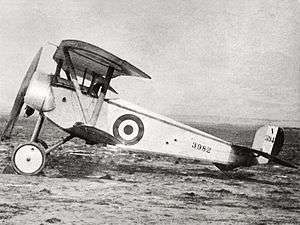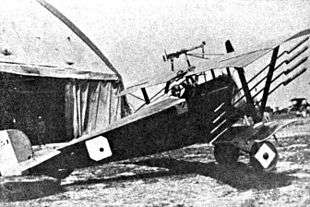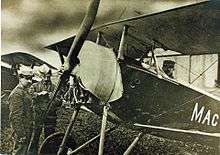Nieuport 11
| Nieuport 11 | |
|---|---|
| | |
| A replica Nieuport 11 in Italian colours | |
| Role | Fighter |
| Manufacturer | Nieuport |
| Designer | Gustave Delage |
| Introduction | 5 January 1916 |
| Status | retired |
| Primary users | Aéronautique Militaire (France) Corpo Aeronautico Militare (Italy), Imperial Russian Air Service |
|
| |
The Nieuport 11, nicknamed the Bébé, was a French World War I single seat sesquiplane fighter aircraft, designed by Gustave Delage.[1] It was the primary aircraft that ended the 'Fokker Scourge' in 1916.[2] The type saw service with several of France's allies, and gave rise to the series of "vee-strut" Nieuport fighters that remained in service (latterly as trainers) into the 1920s.
Design and development

The Nieuport 11 was a smaller, simplified version of the Nieuport 10, designed specifically as a single-seat fighter. Like the "10" the "11" was a sesquiplane, a biplane with a full-sized top wing with two spars, and a lower wing of much narrower chord and a single spar. Interplane struts in the form of a "Vee" joined the wings together. The sesquiplane layout reduces drag and improves the rate of climb, as well as offering a better view from the cockpit than either biplane or monoplane, while being substantially stronger than contemporary monoplanes. The narrow lower wing may be subject to aeroelastic flutter at high air speeds, a problem that manifested itself on the much faster German Albatros D.III and the later "vee-strut" Nieuport fighters.[3] A single example of the Nieuport 11 was modified with a smaller lower wing and canted interplance struts but no further development ensued. Nieuport 11s were supplied to the French Aéronautique Militaire, the British Royal Naval Air Service, the Imperial Russian Air Service, Belgium, and Italy. 646 Nieuport 11s were produced by the Italian Macchi company under licence,[3] and additional Nieuport 16s were built under licence in Russia by Dux. When Romania suffered military setbacks and needed aircraft, several RNAS Nieuport 11s, along with Nieuport 12s were provided.
Nieuport 16

In 1916 an improved version appeared as the Nieuport 16 which was a strengthened Nieuport 11 airframe powered by a 110 hp (92 kW) Le Rhône 9J rotary engine.[2] Visible differences included a larger aperture in front of the "horse shoe" cowling and a headrest for the pilot.[3] Later versions had a fuselage-mounted synchronized Vickers gun, but in this configuration the combined effect of the heavier 9J engine and the Vickers gun compromised maneuverability[3] and made the craft nose-heavy. The Nieuport 16 was an interim type pending the delivery of the slightly larger Nieuport 17 C.1 which was designed for the heavier engine and machine gun with a new, full-perimeter ring cowl, and remedied the 16's balance problems, as well as improving performance.[4]
Operational history

The Nieuport 11 reached the French front in January 1916, and 90 were in service within the month.
This small, sesquiplane outclassed the Fokker Eindecker in every respect, including speed, climb rate and maneuverability. It featured ailerons for lateral control rather than the Fokker's wing warping, giving lighter, quicker roll response, and its elevator was attached to a conventional tail plane which provided better pitch control as opposed to the all-moving, balanced "Morane type" elevators of the Fokker. The Fokker's success was solely due to its synchronized machine gun which fired forward through the arc of its propeller. At the time, the Allies lacked a similar system, and the Nieuport 11's Lewis machine gun[note 1] was mounted to fire over the propeller, allowing uninterrupted forward fire. The Lewis was not synchronizable, due to its open bolt firing cycle design which resulted in an unpredictable rate of fire. Clearing gun jams and replacing ammunition drums in flight were challenging though, and the drums limited ammunition supply. This was eventually resolved in French service by the application of the Alkan synchronization gear with a Vickers machine gun to Nieuport fighters starting with some later examples of the Nieuport 16. The British, in the absence of their own satisfactory synchronizer, continued with the overwing Lewis but employed a new "double" Lewis drum with a capacity of 98 rounds.[4]
During the course of the Battle of Verdun in February 1916, the combination of the Nieuport 11s technical advantages and the concentration of the fighters within the first dedicated fighter units allowed the French to establish air superiority, forcing radical changes in German tactics.
Some Nieuport 11s and 16s were fitted to fire Le Prieur rockets from the struts for attacks on observation balloons and airships.[3]
By March 1916 the Bébé was being replaced by the improved Nieuport 17, although Italian-built examples remained in first line service longer, as did Russian examples. Thereafter the Nieuport 11s and 16 continued to be widely used as trainers.[3]
Variants
- Nieuport 11
- Single-seat fighter/scout biplane. Also known as the Nieuport Bébé or Nieuport Scout although these were used for any Nieuport fighter.
- Nieuport-Macchi 11000 or 11.000
- Variant built under licence in Italy with some detail modifications.
- Nieuport 16
- Improved version powered by a 110 hp (92 kW) Le Rhone 9J rotary piston engine.
Operators
_drawing.jpg)
- Belgian Air Force
- 1ère Escadrille de Chasse
- 5me Escadrille de Chasse
- Corpo Aeronautico Militare (built under licence by Nieuport-Macchi)
- Luchtvaartafdeling (1 example captured)
- Imperial Russian Air Force (some built under licence by Dux)
- Royal Flying Corps - Nieuport 16 only[5]
1st Nieuport 16 delivered on 16 April 1916. 25th and last Nieuport 16 delivered on 6 August 1916.[6]
Survivors and reproductions
- the Musée de l'Air at le Bourget in Paris has the sole original surviving Nieuport 11, currently marked as N556 with the personal markings of Commandant Charles Tricornot de Rose, holder of the first military pilot licence. It had previously been marked as N976.[7]
- Old Rhinebeck Aerodrome has had a reproduction Bébé flying in many of their airshows in past years, finished in Victor Chapman's colors, and powered with an original 80 hp Le Rhône 9C rotary engine.[8]
Specifications (Nieuport 11 C.1)

Data from "The Worlds Greatest Aircraft"[2]
General characteristics
- Crew: one, pilot
- Length: 5.8 m (19 ft 0 in)
- Wingspan: 7.55 m (24 ft 9 in)
- Height: 2.4 m (7 ft 10.5 in)
- Wing area: 13 m² (140 ft²)
- Empty weight: 344 kg (759 lb)
- Loaded weight: 480 kg (1,058 lb)
- Max. takeoff weight: 550 kg (1,213 lb)
- Powerplant: 1 × Le Rhone 9C nine-cylinder air-cooled rotary engine, 59.6 kW (80 hp)
Performance
- Maximum speed: 156 km/h (97 mph)
- Range: 330 km (205 miles)
- Service ceiling: 4,600 m (15,090 ft)
- Rate of climb: 15 mins to 3,000 m (9,840 ft)
- Power/mass: 1.49 kW/kg (0.09 hp/lb)
Armament
- 1 × Lewis or Hotchkiss machine gun
- 8 × air to air Le Prieur rockets for use against observation balloons and airships (optional)
See also
- Circa Nieuport 11 (replica)
- Related development
- Aircraft of comparable role, configuration and era
- Related lists
List of military aircraft of France
References
| Wikimedia Commons has media related to Nieuport 11. |
- ↑ http://www.vazduhoplovnetradicijesrbije.rs/index.php/istorija/102-nijepor-11
- 1 2 3 Chant & Taylor 2007, p. 14.
- 1 2 3 4 5 6 Fitzsimons 1967/1969, p. 1989.
- 1 2 Cheeseman 1960, p. 92.
- ↑ Bruce 1982, p.326.
- ↑ http://www.airhistory.org.uk/rfc/Nieuport.html
- ↑ Rimell, 1990, p.86
- ↑ "Old Rhinebeck Aerodrome - World War 1 Aircraft - Nieuport 11". oldrhinebeck.org. Old Rhinebeck Aerodrome. Retrieved December 19, 2013.
Notes
- ↑ A few aircraft were at first fitted with Hotchkiss guns and, in Italian service, with the Fiat-Revelli until the Lewis was available in sufficient numbers.
Bibliography
- Apostolo, Giorgio (1991). Aermacchi - from Nieuports to AMX. Milan, Italy: Giorgio Apostolo Editore (GAE).
- Bruce, J.M. (1982). The Aeroplanes of the Royal Flying Corps (Military Wing). London: Putnam. ISBN 0-370-30084-X.
- Bruce, J.M. (1988). Nieuport Aircraft of World War One - Vintage Warbirds No 10. London: Arms and Armour Press. ISBN 0-85368-934-2.
- Bruce, J.M. (1994). Nieuport Fighters - A Windsock Datafile Special Volumes 1 & 2. Herts, UK: Albatros Publications. ISBN 978-0948414541.
- Chant, Christopher and Michael J.H. Taylor. The World's Greatest Aircraft. Edison, NJ: Cartwell Books Inc., 2007. ISBN 0-7858-2010-8.
- Cheesman, E.F., ed. (1964). Fighter aircraft of the 1914-1918 War. Letchwordth: Harleyford. ISBN 978-0816863600.
- Charles, Christienne; Lissarrague, Pierre; Kianka, Frances (1986). A History of French Military Aviation. Washington, DC: Smithsonian Institution Press. ISBN 978-0874743104.
- Cooksley, Peter. Nieuport Fighters in Action. Carrollton, Texas: Squadron/Signal Publications, 1997. ISBN 0-89747-377-9.
- Davilla, Dr. James J.; Soltan, Arthur (1997). French Aircraft of the First World War. Mountain View California: Flying Machines Press. ISBN 0-9637110-4-0.
- Fitzsimons, Bernard, ed. The Illustrated Encyclopedia of the 20th Century Weapons and Warfare. London: Purnell & Sons Ltd., 1967/1969. ISBN 0-8393-6175-0.
- Franks, Norman (2000). Nieuport Aces of World War 1 - Osprey Aircraft of the Aces 33. Oxford: Osprey Publishing. ISBN 1-85532-961-1.
- Guttman, Jon (2014). Nieuport 11/16 Bébé vs Fokker Eindecker - Western Front 1916 (Osprey Duel; 59). Oxford: Osprey. ISBN 978-1-78200-353-3.
- Janić Č, Petrović O, Short History of Aviation in Serbia, Beograd, Aerokomunikacije, 2011. ISBN 978-86-913973-2-6.
- Kowalski, Tomasz J (2003). Nieuport 1-27. Lublin: Kagero. ISBN 978-8389088093.
- Longoni, Maurizio (1976). Nieuport Macchi 11 & 17. Milan: Intergest.
- Rimell, Raymond (1990). World War One Survivors. Bourne End, UK: Aston Publications. ISBN 978-0946627448.
- Rosenthal, Léonard; Marchand, Alain; Borget, Michel; Bénichou, Michel (1997). Nieuport 1909-1950 Collection Docavia Volume 38. Clichy Cedex, France: Editions Lariviere. ISBN 2-84890-071-7.
- Sanger, Ray (2002). Nieuport Aircraft of World War One. Wiltshire: Crowood Press. ISBN 978-1861264473.
- Thetford, Owen (1978). British Naval Aircraft since 1912 (Fourth ed.). London: Putnam. ISBN 0-370-30021-1.